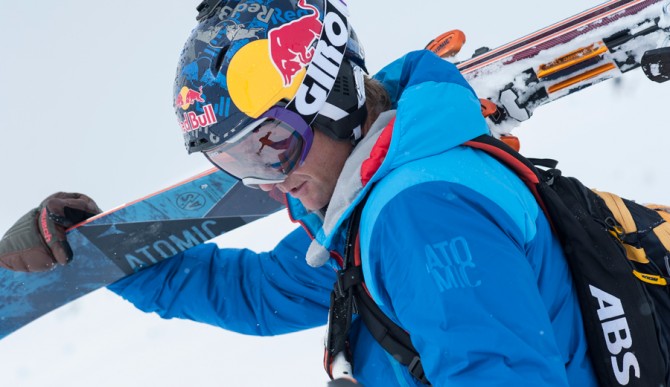
This man has seen his share of snow… Photo: Courtesy of Atomic Austria
As a skier, you face new challenges all the time. And with skiing being an outdoor sport, those challenges are heightened. I’ve been involved in competition (from alpine skiing to ski cross). I’ve also pursued freeskiing. When you spend that much time in the mountains, whatever it is you’re doing, you’re going to learn about yourself — and that’s what makes it such a great sport. There is a real satisfaction of giving something your all and seeing what, in turn, that something brings out of you.
I grew up in the Bay Area. My first time ever skiing was about three years old up in Squaw Valley with my grandparents. We also took annual trips to Aspen over Christmas break. My parents met there so they like going back. We did that for a couple years. When I was 7 years old, my parents got a house up in Alpine Meadows and we would do weekend runs from the Bay, during which I eventually joined the local ski team. It was great to be in that sort of atmosphere with kids my age, bombing around the whole mountain.
It all took off from there. I got into racing gates — it was fun, you know, to see who’s fastest going down the mountain. That sort of just progressed over time and I ended up leaving Tahoe for Vermont, heading back east for a ski academy because there was nothing like that in Tahoe, at least nothing that was a good balance of school and skiing. I ended up doing four years in Vermont; I was like 14 years old and all the kids were mainly my age. The best riders were from the east coast. I figured that if was going to racing, a good place to train would be among the highest rank athletes in the United States. And trips to Europe were much easier access leaving from the east coast, which I began participating in when I was 16.
Back then, skiing was all fun. It never really got serious until I was 17. Before all that it was more about having those experiences and the drive of seeing how good you were, or could be. And it wasn’t only skiing. Even when I played soccer, I would run until I was barely able to breath and basically passed out. I went so hard that I had self-induced asthma! It was about pushing myself — and people don’t think there’s much mental side when you’re a young kid to push yourself, but there is. And that is when you learn and really realize how important the mental side is. But you have to level it out with skill and understanding.
I’ve always been pushing myself. Then I started having good success in ski racing and a little light went off. Once you get to Europe, and are racing in the World Cup, you realize how big the sport is. It has this huge following, and is on the news and in magazines practically everyday. It’s a totally different sport there than in the U.S. We were faced with some of the gnarliest, toughest tracks — the kind you couldn’t even dream of, ones they won’t even build anymore for safety reasons. That was my life, through and through: ski racing. And I trained really hard. I wanted to do a downhill because it’s fast — it’s the ultimate race. I was told don’t bother: you don’t have the size for it and it’s not your style. But that was what I wanted to do, so I did. I committed myself, studying and tuning my skills and body as much as possible, mostly for downhill.
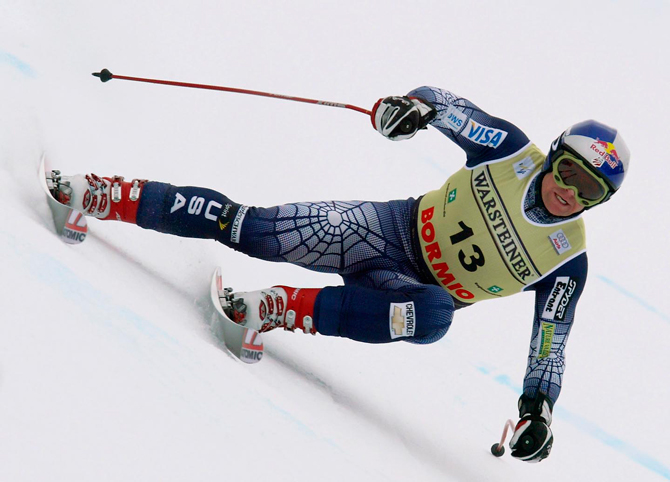
Bormio, Italy for the downhill World Cup. Photo: Courtesy of Daron Rahlves
Next season, I competed in my first World Cup. I felt like I had a point to prove. My risk taking and scrappiness overcame whatever size and style disadvantages critics saw, and ultimately made me rather successful in downhill. Though that’s not to say there weren’t a handful of brutal falls in the process…
At the peak of my racing career, I was traveling a lot — spending about eight months out of the year on the road. In 2003, I married. Three years later, we began having kids. I didn’t want to try and raise a family while I was racing, so I made one last run of it in 2006, figuring I would end strong. But in 2007, ski cross sort of fell into my lap. Kipp Nelson, on the board of directors of the U.S. ski team at the time, had made a lot of money in the financial world and decided he wanted to start a tour for skiing — it was going to focus on ski cross and halfpipe thinking that exposure and the subsequent popularity might encourage the International Olympic Committee to consider those disciplines more seriously. Boardercross made it into the Olympics in 2006, and he had this idea that his tour would be a grooming stage for the Olympics. (Both eventually made it in.) Anyway, ski cross was perfect for me. I had a lot of friends from my downhill world that were also participating in ski cross — guys that used to be on the U.S. ski team and now they were on a different tour doing something different, but still on skis. And with ski cross, we were doing it together, going head to head at the same time instead of against the clock. I loved it.
My first year, I was the fastest-ever qualifying, but come race day, I made the finals and simply blew it — I didn’t have the starts down so I was coming from the back of the pack and trying to push too hard and make passes where it wasn’t smart. In my first X-Games, again in the finals, I went down on the third turn — once more I was just pushing too hard to make a pass at the wrong place. But the next year I tweaked and fine-tuned and ended up winning the X-Games.
Honestly, ski cross was what you did after you were done with downhill racing, or maybe didn’t make it to the next level. Ski cross took that group, at least those who still had a little left in the tank — and something to prove. And big mountain was the next step, albeit a step that I started taking during my racing career.
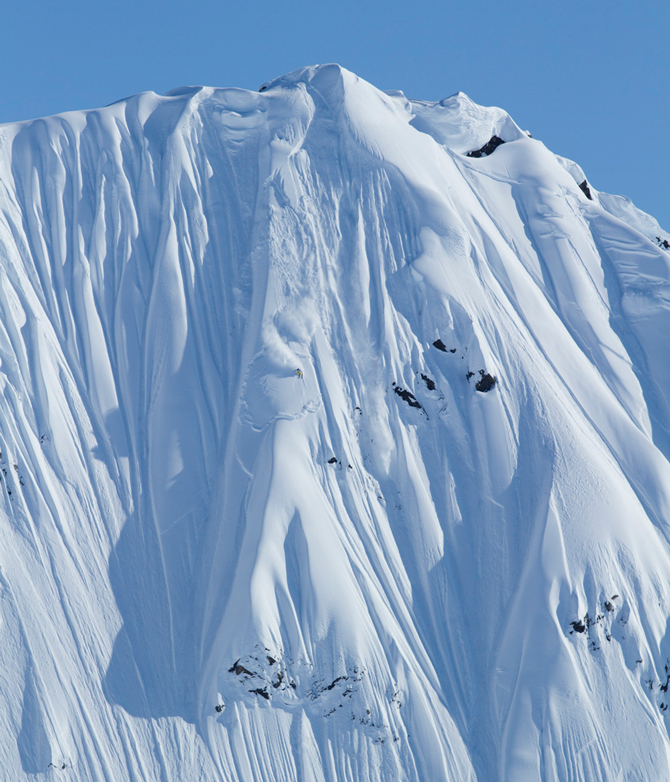
One hell of a spine in Knik, Alaska. Photo: Courtesy of Teton Gravity Research | Adam Clark
It began back when I was on the U.S. ski team with Jeremy Nobis. He would go ski Alaska and was the first to ski super fast down those mountains, opening it up and pulling huge turns at 50 miles per hour. I remember him telling me that it was way gnarlier in downhill racing. This was when I was still getting scared out of the gates at the World Cup, and that didn’t even come close to comparing to Alaska.
I won World Championships in 2001 in Austria and that next April Reggie and Zach Crist convinced me to go up to Haines, the place everyone was going in Alaska. I went up there and loved it, going up for a week or so the following springs. It was while up there that I jumped in with a company called Rage Films and had a little part in their movie — it was fun. From then on out, whenever I had a chance I was freeskiing. With the World Cup there wasn’t much time when you were not testing equipment and training in racing. So I was always ready to go freeskiing. I started getting more educated and learning from personal experience as well as paying attention to what the guides were doing. Then I started looking for the most difficult lines, ones that would really push me. As a racer, you train so much on your technique on your foundation of good skiing and it transfers over to freeskiing if you want to take it there. You have to memorize a lot of like terrain and how the course is running kind of where to push and where to hold back. Same thing with big mountains.
What kept me going originally and has kept me going since I retired from racing was and is the adrenaline — if you crash up there in a place like Haines, there are no nets to catch you; there’s intense exposure; and conditions you’re never 100% sure on. That’s what initially drew me. But as I’ve gotten older, and had a few close calls, I’ve become more selective and more careful. That’s what it’s about: longevity. I’ve had so many great experiences, and what is cool when I look back on them is that I’m still involved with years and years ahead of me. It had a lot to do with the timing of going into ski cross and then into big mountain while I was still strong and on top of my game — I wouldn’t want to change that for anything. To balance it skiing out with family life — it’s perfect.
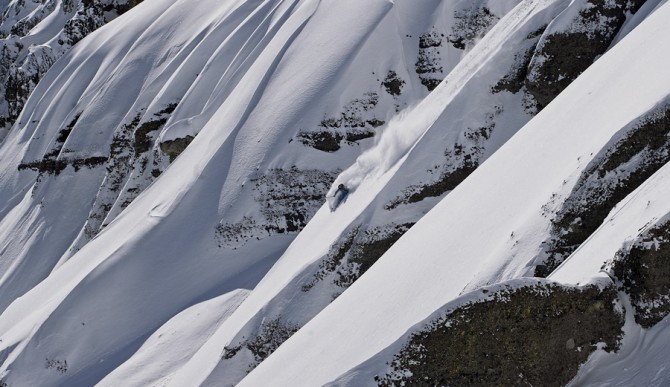
Time for these lines in Sugar Bowl back country and family. Photo: Courtesy of Grant Barta
These days, it is more and more difficult to find a physical progression, especially with regard to how much risk I want to take. But that doesn’t mean I need to walk away, even from competitions. I went back to Kitzbühel once, which is the most dangerous and treacherous race on the World Cup circuit. I went back after seven years of being away from downhill racing — that was a big deal for me, revisiting my favorite race, and not just going there to watch, but taking part in inspection and training runs. For me, that was a progression. I came back and I had to kind of jump right back into it. By no means was I racing (even though I did ski it). And now I’m in the fifth season of running the Rahlves’ Banzai Tour up here in Tahoe. My intention was to combine the elements of freeskiing and racing and putting it in an all-mountain setting, with four coming down at a time, like ski cross. It represents most components of my personal career.
I love the passion that competition brings out. And because of that passion, when I was a racer, I was selfish. It is, for most people, a selfish life. I did everything for myself. Today, I’m at a point in my life where I want to help others pursue that passion; I like seeing people get the same feelings and have the same experiences I did. I feel that having kids when that transition happened. I’m the father of twins, 7 years old. Taking them up on the mountain (like my parents did for me) on a lunch break, finding a cool spot, and looking out over Donner Summit off Sugar Bowl while watching their faces light up is what gets me.
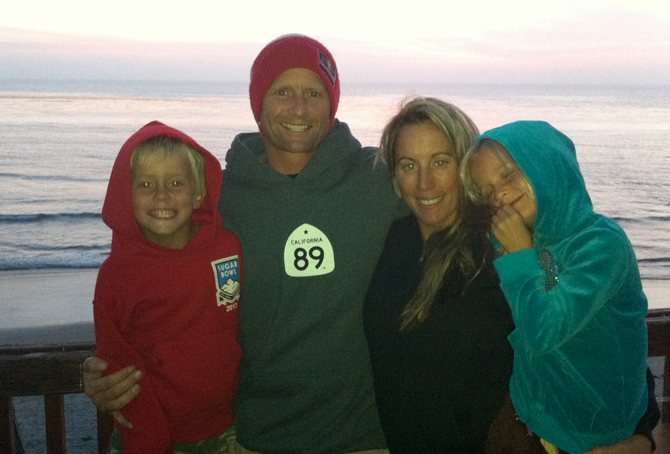
What matters the most. Photo: Courtesy of Daron Rahlves
The sport has transcended competition. And that is what progression means to me now: passing on what I’ve learned in hopes of inspiring younger skiers, from my own children to up-and-comers. I’m even mentoring a kid on the U.S. ski team, Travis Ganong. I’m attracted to him because he has that passion for skiing and he’s a really hard worker and a damn good racer. Last year was his first year on the World Cup podium and he got third place in Kvitfjell, Norway, where, funnily enough, I won my first World Cup downhill in 2000. And he was fifth at the Olympics. It’s cool to support a kid like that, a kid who is fully committed and able to adapt what they’re doing.
At the end of the day, accomplishments are great, but you want to know that you put everything you had into something — that’s all you can ask from yourself.
To keep up with Daron Rahlves, check out his site and his athlete bio on RedBull.com. Also, be sure to follow him on Instagram and Twitter, and Like him on Facebook.

